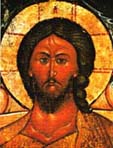| Disputes
shaping the orthodox teaching that Jesus Christ is one person with
two natures, one fully human and the other fully divine. |
 |
|
|
These controversies
occurred against the background of the Trinitarian
controversies in which orthodox teachers maintained that Christ is
of one substance with the Father. How, then, theologians asked, can Christ
also be fully human? Three preliminary answers were eventually condemned
as heretical. Apollinarianism maintained
that in Jesus the Word of God (Logos)
took the place of a human mind. Nestorianism
taught that in Christ there are two distinct natures and two distinct
persons. Eutycheanism held that Christ
is of one substance with the Father but not of one substance with humankind.
All of these alternatives were eventually rejected by orthodox teachers.Two
theologians in particular contributed to the development of orthodox teaching.
Cyril of Alexandria from the East taught that in Christ there are two
complete and distinct natures, a human and a divine, which are however
of the same and undivided substance. Pope Leo I from Rome
maintained that Jesus Christ is one person of the divine Trinity with
two distinct natures that are permanently united. These two natures share
properties through the so-called communicatio
idiomatum or sharing of attributes between the divine and human
natures of Christ. The
Council of Chalcedon (451) affirmed
that Christ is one hypostasis or prosopon ("person") with two natures,
one fully human and one fully divine. These two natures are said to share
or communicate attributes through the so-called communicatio
idiomatum. Chalcedon thus condemned extreme Antiochene tendencies
in rejecting the teachings of Nestorius, but respected the two natures
of Christ. The council resisted extreme Alexandrian teaching in repudiating
Eutyches, but accepted the teaching of Cyril of
Alexandria. It also incorporated elements of Roman teaching from
the Tome of Leo. It thus combined Antiochene,
Alexandrian, and Roman tendencies.
After the Council of Chalcedon, some opponents of its teaching advanced
monophysite views which tended toward the position that Christ was of
one human nature. Still later, others urged a monothelite position, arguing
that Christ has two natures but the one divine will of the Logos. In time,
however, the Chalcedonian position prevailed throughout most of the churches
of the East and the West.
|